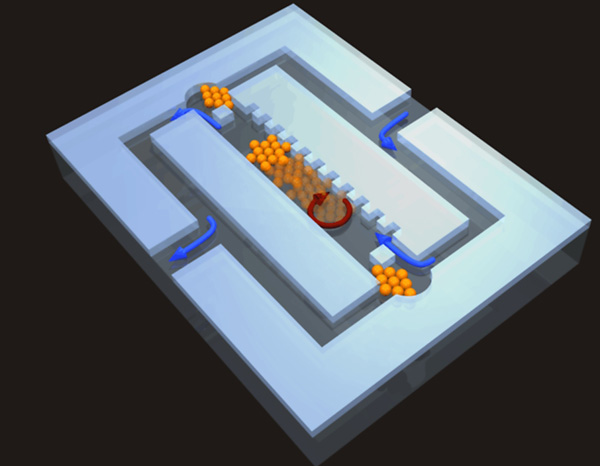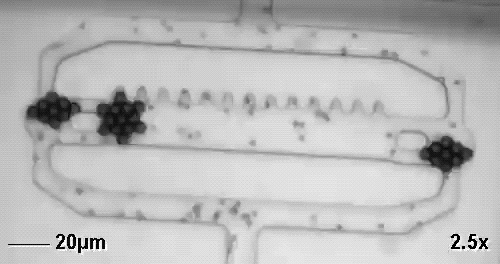
Microfluidic Devices Powered By Colloidal Particles
The experimental realization of microscale devices able to manipulate small amounts of liquids (~nl-pl) is the basis for the development of so-called lab-on-a-chip systems, portable units that are capable of performing all types of chemical or biological analysis. Such systems consist of complex networks of multiple pumps, valves, mixers, reaction chambers, analyzers, and so on. One significant hurdle for present lab-on-a-chip systems to overcome is the question of how to deliver the necessary energy to each of these single devices across length scales from our macroscopic world to micrometer sized objects. In fact, this problem hinders most of the commonly used approaches to develop highly complex systems with massively parallel architectures. We present an approach to realize microfluidic devices that, by the combination of local geometry and global magnetic fields, enables us to power fabricated units in a parallel, locally uncoupled, and integrated fashion. Paramagnetic colloidal particles thereby represent the building blocks that are assembled in-situ into the moving parts of the microfluidic devices in confining geometries, similar to a Ship-in-a-Bottle. Rotating magnetic fields in the sample plane lead to attraction between single particles and exert a torque to clusters of paramagnetic colloids. Therefore, magnetic fields offer not only the possibility to non-invasively fabricate and actuate microfluidic devices, but also to run thousands of these tiny machines simultaneously.

Our work in the press
- German press release
- English press release
- Frankfurter Allgemeine Zeitung (Anne Hardy): Magnetisch ferngesteuerte Mikrolabore
- Journal of Nanotechnologies: Ship in a Bottle Kit on a Microchip
- Innovations Report: Mikrochip als Buddelschiff
- Computer Zeitung: Max-Planck baut ein Labor im Chip zusammen
- Focus Nr. 51 2008 (Matthias Matting): Alter Kniff für neue Technik
- Research Review (Sarah Collins): Labs on a chip
- Max Planck Forschung 1.2009: Mikrochip als Buddelschiff
